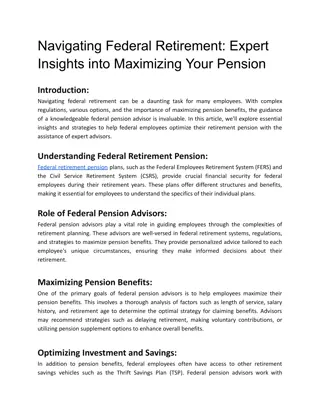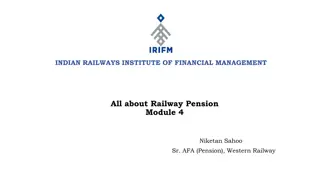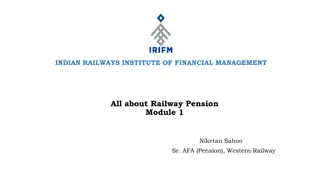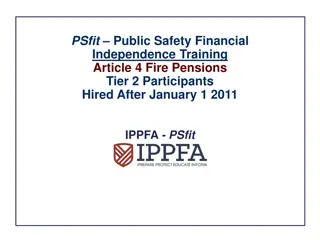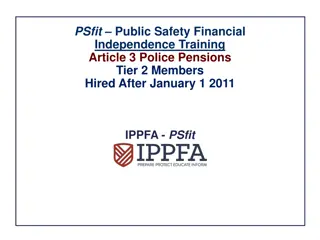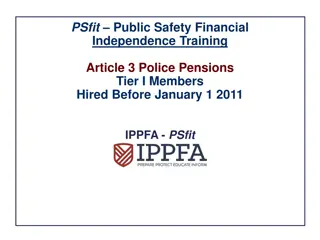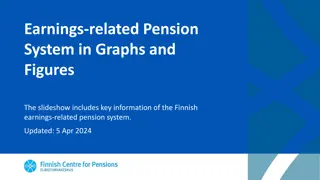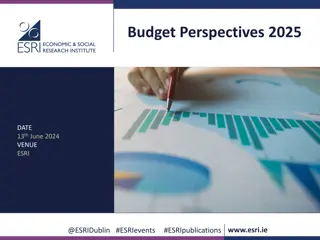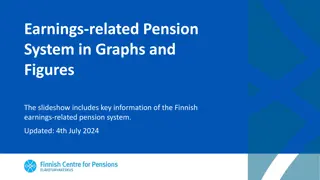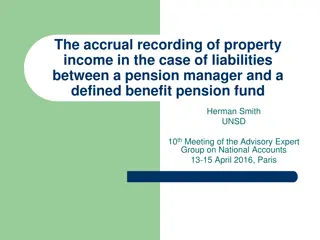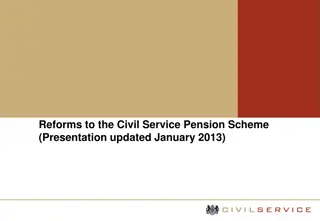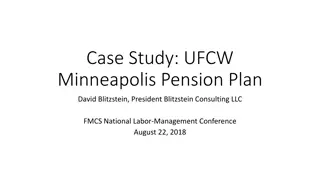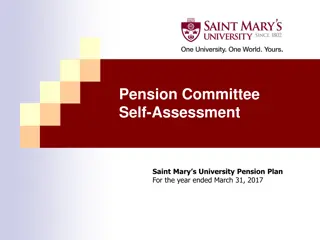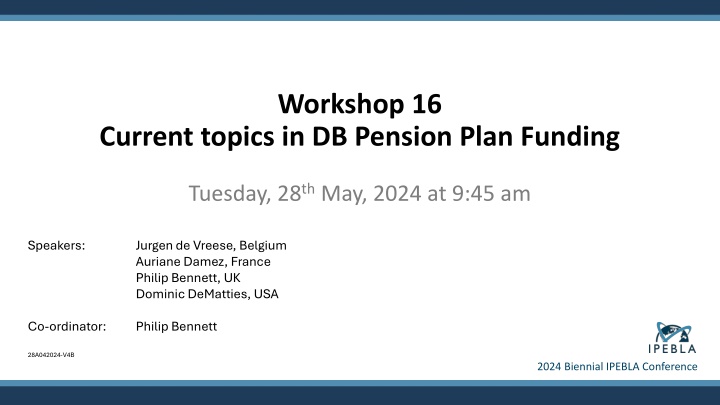
Insights into DB Pension Plan Funding: Current Topics and Challenges
Delve into the latest discussions at the 2024 Biennial IPEBLA Conference on pension plan funding, including topics such as different approaches to Pillar 2 and Pillar 3 pensions in France, the impact of rapid increases in discount rates, liability for deficits, and more. Explore the necessity of funding DB plans in various jurisdictions and the nuances of pension structures across different countries. Gain valuable insights from global experts in the field.
Download Presentation

Please find below an Image/Link to download the presentation.
The content on the website is provided AS IS for your information and personal use only. It may not be sold, licensed, or shared on other websites without obtaining consent from the author. If you encounter any issues during the download, it is possible that the publisher has removed the file from their server.
You are allowed to download the files provided on this website for personal or commercial use, subject to the condition that they are used lawfully. All files are the property of their respective owners.
The content on the website is provided AS IS for your information and personal use only. It may not be sold, licensed, or shared on other websites without obtaining consent from the author.
E N D
Presentation Transcript
Workshop 16 Current topics in DB Pension Plan Funding Tuesday, 28th May, 2024 at 9:45 am Speakers: Jurgen de Vreese, Belgium Auriane Damez, France Philip Bennett, UK Dominic DeMatties, USA Co-ordinator: Philip Bennett 28A042024-V4B 2024 Biennial IPEBLA Conference - Limited distribution -
Today we are covering: I. II. Pillar 2 and Pillar 3 pensions in France: A different approach III. Impact of very rapid increases in discount rates IV. Liability for deficits V. LDI and LLDI: A search for stability and affordability VI. Using funding surplus to derisk with an insurance company VII. Issues arising from insolvency of insurance company VIII.Using surplus to provide benefits for future service Some background and context 2024 Biennial IPEBLA Conference - Limited distribution -
I. Some background and context 2024 Biennial IPEBLA Conference - Limited distribution -
Setting the scene The 3 pillar classification approach: Pillar 1: State social security pension Pillar 2: Employer sponsored occupational retirement pension or lump sum (but for France structured to be a type of social security pension complementing Pillar 1) Pillar 3: Individual retirement savings (usually with tax advantages) except for France where Pillar 3 corresponds to Pillar 2 for the other 3 jurisdictions and individual plans What do we mean by DB pensions in this Workshop? Answer: Anything which includes a hard or soft guarantee including: US: Anything that is not a DC plan (such as cash balance plans) Belgium: DC plans France: AGIRC/ARRCO (see later) and insurance contracts offering DB UK: Anything which is not a money purchase benefit 2024 Biennial IPEBLA Conference - Limited distribution -
Setting the scene (contd) Must DB Plans be funded? Belgium: Pillar 2, yes France: Pillar 2 = No. Pillar 3 = Yes UK: Pillar 2, free market but private sector is usually funded for tax and security reasons unfunded are executive top ups (UK ignores Article 8 of Directive 2008/94/EC for these unfunded plans) US: Private sector, yes required by law (ERISA, Internal Revenue Code, and/or applicable state/local law), but with some limited exceptions (executive top ups) For Belgium, France and UK: Directive 2008/94/EC, Article 8 and associated ECJ decisions: Robins (C-278/05) Hogan (C-398/11) Hampshire (C-17/17) Bauer (C-168/18) 2024 Biennial IPEBLA Conference - Limited distribution -
Setting the scene (contd) Can the traumas for employers with funded DB plans in the 2008- 2023 be solved with a pay as you go DB plan? What issues does such an alternative approach raise in calculating the contributions and benefits for an unfunded DB plan with a stabilisation reserve fund ? Let s look at the approach in France 2024 Biennial IPEBLA Conference - Limited distribution -
II. Pillar 2 and Pillar 3 pensions in France: A different approach 2024 Biennial IPEBLA Conference x - Limited distribution -
The pension system in France Company-level pension scheme, Optional systems (DB / DC) Mandatory complementary pension scheme AGIRC / ARRCO Mandatory basic scheme, statutory pension 2024 Biennial IPEBLA Conference - Limited distribution -
The pension system in France (contd) More than 30 Pillar 1 and Pillar 2 pension schemes in France for different occupations and professions with compulsory contributions and membership In 2023, pension system reform unified few schemes to continued Pillar 2 pensions are pay as you go (unfunded except for any buffer or smoothing fund) with compulsory membership and contributions. IORP Directive (Directive 2003/41/EC replaced by Directive 2016/2341) does not apply to pay as you go schemes (Article 2(2)(c)) Article 8 of Directive 2008/94/EC does not apply. The AGIRC ARRCO agreement (national inter-occupational agreement 17th November, 2017 article 55) ensures that non-payment of contributions does not affect employees benefit entitlement (so far as the employees contributions have been deducted at source from the remuneration paid and working period must have been validated by the basic scheme) 2024 Biennial IPEBLA Conference - Limited distribution -
Pillar 3 pensions in France Pillar 3 employer sponsored plans can be: Long-term savings plan (PERCO or PERCOL) A DC plan (PER-OB) A DB plan with an IORP (or with an insurance provider) Note: DB plan insolvency protection to comply with Article 8 of Directive 2008/94/EC Tax advantages provided for these plans Provider structures Insurance companies French IORP (a Fonds de Retraite Professionelle Suppl mentaire or FRPS) : treated as an insurance company for French regulatory purposes but can use the solvency capital rules from the Solvency I Directive (now in the IORP II Directive (EU (2016/2341)) at Articles 15-18) 2024 Biennial IPEBLA Conference - Limited distribution -
AGIRC/ARRCO: Some details AGIRC/ARRCO: Some details Association G n rale des Institutions de Retraite des Cadres (AGIRC)/Association des R gimes de Retraites Compl mentaires (ARRCO) AGIRC/ARRCO: AGIRC: for executives / ARRCO: for non executives Schemes were merged into a single scheme on 1st January, 2019 Pillar 2 scheme for private sector employees with compulsory membership and compulsory contributions by employers and employees 2024 Biennial IPEBLA Conference - Limited distribution -
How are AGIRC/ARRCO contributions calculated? Contributions Pay on which contributions are payable : all the pay components that go into the Social Security contribution basis (gross salary) The main contribution is used to purchase retirement points And two or three other additional contributions are used to balance the scheme Contributions are paid by the employer (60%) and the employee (40%) Specific point on the main contribution There are 2 brackets of eligible pay and each bracket of eligible pay has its own contribution rate The contribution rate for each bracket is divided by an adjustment factor (1.27) to calculate the amount of the main contributions that is eligible to purchase pension points (see next slide) 2024 Biennial IPEBLA Conference - Limited distribution -
How are AGIRC/ARRCO pension points calculated?: Point calculation rates Source: https://www.cleiss.fr/docs/regimes/regime_france/an_3.html Use pay that counts for social security contributions Bracket 1: between 0 and 3864 (1 monthly Social security ceiling) Point calculation rate (Total divided by 1.27) 6.2% Employee's rate 3.15% Employer's rate 4.72% Total 7.87% Bracket 2: between 3864 and 30912 (8 times the social security ceilings) 8.64% 12.95% 21.59% 17% 2024 Biennial IPEBLA Conference - Limited distribution -
AGIRC/ARRCO: Calculation of points obtained each year Points obtained each year Number of points = gross salary (structured in wage brackets) Point calculation rate for bracket DIVIDED BY point purchase price The purchase price of the point is fixed each year The point purchase price is determined on the evolution rate of the average salary of the members of the AGIRC ARRCO scheme, possibly adjusted by a sustainability factor, taking into account the economic situation and the labour market (for how see later slide covering safety valves) Point purchase price in 2024 : 19.6321 2024 Biennial IPEBLA Conference - Limited distribution -
How is your AGIRC/ARRCO pension calculated?: Calculation of pension: Overview Your pension is calculated as an annual amount determined by: multiplying your number of pension points by the pension/annuity rate per point at that date Since the 1stNovember 2023 : 1.4159 Note: More detail (in French) here: https://www.agirc-arrco.fr/ma-retraite/comprendre- ma-retraite/ma-retraite-a-quel-age/ 2024 Biennial IPEBLA Conference - Limited distribution -
Simplified example Born in 1961 Retirement in 2025 (at age 64) Annual gross salary : 30,000 ( 2,500 per month)NB: Does not exceed Bracket 1 Samesalary throughoutthe careerwith an annual increasein the sameproportion as the purchasevalue of the point Points obtainedeachyear : 94.75 points (30,000 x 6.20% / 19.63 = 94.75) Period of working : 42 years(later 43 years withthe implementationof the reform) Estimatednumberof points : 42 x 94.75 = 3980points pension/annuity rate per point in 2024 : 1.4159 annuity: 3980 x 1.4159 = 5,635 Euros per year Note : social security annuity= 15,000 per year 2024 Biennial IPEBLA Conference - Limited distribution -
AGIRC/ARRCO ? Some additional considerations Solidarity Points are purchased by contributions (see previous slides) But points are also awarded with no payment of contributions: for periods of incapacity for work lasting more than 60 consecutive days for which the insured drew social security daily allowance, industrial accident insurance benefits, disability pension, and maternity leave The cost of a pension point under the AGIRC/ARRCO scheme is the same irrespective of the employee s age- intergenerational solidarity 2024 Biennial IPEBLA Conference - Limited distribution -
AGIRC/ARRCO: Safety valves The safety valves: The following can be adjusted: the conversion factor of how much of the contributions buys pension points (currently only 78.7% ie 1/1.27) the contribution rates the cost of a pension point ( 19.6321 in 2024) the pension conversion factor ( 1.4159)- this is adjusted periodically and reapplied to all pensions in payment to provide for increases to pensions in payment. The additional contributions collected (excess over those that buy pension points) are invested to provide a reserve fund to reduce the risk of having to reduce the pension conversion factor. The safety valves are negotiated by Trades Unions and employer organisations who signed the National AGIRC ARRCO agreement. If change is necessary, parties must collectively seek a solution. Failure to do so may result in the termination of the agreement which couldn t be considered given the social protection provided by the AGIRC ARRCO scheme. 2024 Biennial IPEBLA Conference - Limited distribution -
III. Impact of very rapid increases in discount rates on DB scheme funding 2024 Biennial IPEBLA Conference x - Limited distribution -
Discount rates Reminder Use to calculate today amount of future payment obligations of pension plan Could be the inverse of the expected investment return on the assets of the pension plan (where funded) Different discount rates can be used for different purposes: In the accounts of the sponsoring employer where the plan deficit or surplus will appear as a liability or asset in the balance sheet Funding purposes for the pension plan Calculation of transfer values, plan termination, or conversion of pension into retirement lump sum (or vice versa) Discount rate for accounting purposes specified in applicable accounting standard For stock exchange listed companies in Belgium, France and UK under IAS 19 In US: FASB ASC 715 Discount rate prescribed under both sets of accounting standards as derived, in general terms, from yield at balance sheet date of bonds (AA credit rating) of corresponding maturities to the retirement obligations of pension plan 2024 Biennial IPEBLA Conference - Limited distribution -
Discount rates for funding purposes Jurisdiction Belgium How determined 1.1 Prudent discount rate. 1.2 Derived from expected return on pension fund/insurance company investments OR high quality bonds OR a combination. 1.3 Legal maximum of 6% pa. FSMA (Belgium regulator) to consider prudent rate on a case-by-case assessment. 2.1 Prudent discount rate. 2.2 Derived from expected return on pension fund/insurance company investments OR high quality bonds OR a combination Notes Under Belgian legislation transposing IORP II Directive, Article 13(4) France 2.1 Under French legislation transposing IORP II Directive, Article 13(4) for French IORPs 2.2 Not applicable to French Pillar 2 pension schemes (as pay as you go unfunded but not book reserve) 2024 Biennial IPEBLA Conference - Limited distribution -
Discount rates for funding purposes (Contd) Jurisdiction How determined Notes UK 3.1 Prudent discount rate. 3.2 Derived from expected return on pension fund investments OR high quality bonds OR a combination. 3.3 Rate usually to be determined by plan trustee/fiduciary and employer. In default of agreement fixed by UK Pensions Regulator (no reported determination as parties usually agree given what Regulator may determine) 4.1 For private sector employer plans specified in regulations (no discretion) 4.2 For collectively bargained plans covering more than one employer (multiemployer plans), must be reasonable and represent the actuary s best estimate of anticipated experience 4.3 For governmental plans specified in applicable local law 3.1 Under UK legislation transposing IORP II Directive Article 13(4) 3.2 Currently unaffected by Brexit USA 4.1 Internal Revenue Code and Regulations under it 4.2 Tax revenue incentive for Congress to keep discount rate higher as reduces deficit (and therefore tax deductible employer contributions) 2024 Biennial IPEBLA Conference - Limited distribution -
Discount rates for funding purposes (contd) Discount rate does not affect the amounts of retirement benefits payable in the future but does affect funding calculations Central banks lawfully rigged the interest rate market following the 2008 financial crisis to reduce interest rates to historically low levels (even negative in Euro zone) So where discount rate is derived from the yield on high quality bonds, present amount of future payment obligations is increased (with funding impact and accounting impact on employer balance sheet) 2024 Biennial IPEBLA Conference - Limited distribution -
Changes in interest rates on 10 year Government Bonds in the 2 years from January 2022 Country 1st January, 2022 1st January, 2023 1st January, 2024 Interest rate in Column 4 Interest rate in Column 2 5.25 8.84 3.28 2.3 Belgium France UK USA 0.55% 0.31% 1.20% 1.76% 2.93% 2.69% 3.51% 3.53% 2.79% 2.74% 3.93% 4.06% 2024 Biennial IPEBLA Conference - Limited distribution -
Changes in interest rates in the 2 years from January 2022: Impact on DB plan funding Could the rapid increases have been anticipated after 13 years of ultra low rates? But for LDI and LLDI (more later), a massive improvement in funding Suddenly surpluses have replaced deficits for many DB pension plans (even if asset values may be down substantially) But some using LLDI ended up the wrong side of a long/short carry trade (more later) Surpluses are leading to a substantial increase in derisking/LDI/buy-in or plan termination and buy-out for DB benefits with insurance companies Is this just transferring DB pension risk to another part of the financial world insurance companies- with a potential boomerang liability for plan employers - Limited distribution -
IV. Liability for deficits 2024 Biennial IPEBLA Conference x - Limited distribution -
Employer liability for deficit: DB Pillar 2 private sector funded plans (Pillar 3 for France) Jurisdiction Belgium Legislative requirement Yes, if insufficient amounts can be paid by pension fund/insurance company on trigger point occurring Yes, if insufficient amounts can be paid by pension fund/insurance company on trigger point occurring Yes, if insufficient amounts can be paid by pension fund/insurance company on trigger point occurring Yes, if insufficient amounts can be paid by pension fund/insurance company on trigger point occurring Note: Exceptions for US multiemployer plans Notes Trigger points vary from jurisdiction to jurisdiction as does calculation methodology and amount of additional employer contributions payable France UK USA 2024 Biennial IPEBLA Conference - Limited distribution -
Employer liability for deficit in these plans (cont d) Belgium/France:Where insurance company/ IORP becomes insolvent employer still fully liable for 100% of shortfall. If employer then becomes insolvent then Article 8 of Directive 2008/94/EC will apply (requiring at least 50% of the members benefits to be covered by compensation scheme which may not be sufficient to satisfy Article 8 requirement) UK: Employer fully liable for 100% of shortfall with the employer s obligations, in general, back-stopped by the UK Pension Protection Fund up to a certain percentage of the benefits with at least Article 8 50% value post ECJ in Hampshire (but, post Brexit, for employer insolvencies after 1st January, 2024, excluding ECJ Bauer underpin), unless DB plan fully wound up and good discharge received on buy-out of benefits with insurance company (or other good discharge buy-outs occur while plan continues for groups of bought-out members in respect of those groups of members) 2024 Biennial IPEBLA Conference - Limited distribution -
Employer liability for deficit in these plans (cont d) US: Employer (including all companies in employer control group) fully liable for 100% of any shortfall of assets as compared to the employer s obligations If the employer does not have sufficient resources to satisfy all obligations to the plan while remaining a going concern, liabilities to participants are back- stopped by the US Pension Benefit Guaranty Corporation (PBGC) up to a maximum guarantee, which is approximately $7,000 monthly at age 65 in 2024 (generally requires PBGC agreement or determination in bankruptcy) If PBGC agrees that assets are sufficient (including by employer satisfying liability for 100% of any shortfall at the time), DB plan fully wound up and good discharge received on buy-out of benefits with insurance company (or other good discharge buy-outs occur while plan continues for groups of bought-out members in respect of those groups of members) 2024 Biennial IPEBLA Conference - Limited distribution -
V. LDI and LLDI: A search for stability and affordability x 2024 Biennial IPEBLA Conference - Limited distribution -
LDI and LLDI: A search for stability and affordability What is it? LDI = liability driven investment LLDI = leverage liability driven investment Why use LDI? Aim is for the value of plan assets to align with the amount of the plan benefit payment obligations to avoid/dampen down size of deficit as at an annual or triannual valuation date Why use LLDI? To use economic borrowing or gearing to reduce the size of the deficit Genius investment strategy in period from 2008 to start of 2022 A good idea until it ceased to be a good idea in September 2022 Nothing more than a long/short interest rate arbitrage or speculation 2024 Biennial IPEBLA Conference - Limited distribution -
Example of LDI Belgium: Employer uses a branche 21 insurance contract for its DC guarantee minimum return pension plan AND insurer guarantees the minimum required return NB: Employer always must guarantee a minimum return. Employer can choose for branche 21 (also minimum guarantee to be offered by the insurance company) or branche 23 (no minimum guarantee to be offered by insurance company or pension fund) France: Not applicable for Pillar 2 pensions (and Pillar 3 DB pension plans relatively small) UK: Holding matching assets when cash flow from the asset closely matches the benefit obligation payment dates or Synthetically using fixed/floating interest rate swap derivatives or Insurance company buy in policies US: As for the UK frequently monitored by reference to the employer s funded status for financial accounting purposes 2024 Biennial IPEBLA Conference - Limited distribution -
LDI: Some legal issues Prudent person rule/duty of loyalty to pension plan Is this investing plan assets for the highest risk adjusted return, or Is it investing plan assets to be in balance with the discounted amount of the plan pension payment obligations as at a balance sheet date/valuation date for the benefit of the employer? US: ERISA Section 404 (see DoL advisory opinion:https://www.dol.gov/agencies/ebsa/about- ebsa/our-activities/resource-center/advisory-opinions/2006-08a ). Requirement under IORP II Directive, Article 19(1)(d) to invest predominantly on regulated markets with investments not traded on a regulated market being kept to prudent levels Question: How does this square with plan assets invested predominately in buy-in policies transferring longevity and interest rate risk to the insurance company in exchange for credit risk on the insurance company? 2024 Biennial IPEBLA Conference - Limited distribution -
LLDI: Some legal issues IORP II Directive, Article 19(3) prohibits IORPs from borrowing other than for temporary liquidity purposes UK DB IORPs were using 6-12 month repos ( 64.6 billion in December 2019) to borrow in economic terms, invest in higher yielding/high return assets, and rolling the repos 2024 Biennial IPEBLA Conference - Limited distribution -
LLDI: Some legal issues Does the IORP II Directive, Article 19(3) restriction on borrowing extend to economic borrowing and repos? EIOPA Technical advice for review of the IORP II Directive (EIOPA-BoS- 23/341 28 September 2023) EIOPA consultation on proposed changes to IORP II Directive at footnote 66: 66 To keep the leveraged government bond position in place, this hedging strategy involves rolling over the short-term repo borrowing turning it into structural, long-term borrowing, which is not permitted by the IORP II Directive. Article 19(3) of the provides that IORPs shall be prohibited from borrowing. Member States may only authorise IORPs to carry out some borrowing for liquidity purpose and on a temporary basis. Therefore, hedging strategies involving structural borrowing are not further considered in relation to IORPs. More here on the UK: https://www.durham.ac.uk/media/durham-university/departments-/law- school/pdfs/news-pdfs/Leveraged-LDI---Prudent-deficit-risk-manage-or-ultra-vires-speculation.pdf Note: also looks at legality of using derivatives for leverage 2024 Biennial IPEBLA Conference - Limited distribution -
LLDI: Some legal issues (contd) Leveraged LDI not used in the US because tax rules on unrelated business taxable income make this unattractive. 2024 Biennial IPEBLA Conference - Limited distribution -
VI. Using funding surplus to derisk with an insurance company x 2024 Biennial IPEBLA Conference - Limited distribution -
Using funding surplus to derisk with an insurance company One consequence of the increase in interest rates for DB pension funds not using LDI/LLDI (or using to limited extent) is : Even if the value of Plan assets may have fallen, the present amount of future benefit payment obligations has fallen faster if the discount rate used is based on the yield of high quality bonds of corresponding durations and could have doubled or trebled (see Table on earlier slide) Leading to large valuation surplus Leading to the use of this valuation surplus to de-risk/de-risk further for those plans not using LDI: One de-risking strategy is to purchase buy-in insurance contracts to cover as much of the benefit payment obligations as can be afforded. This exchanges interest rate and longevity risk for credit risk on the insurance company. 2024 Biennial IPEBLA Conference - Limited distribution -
Using funding surplus to derisk with an insurance company This gives rise to some legal considerations including: Prudent person rule and diversification Duty of loyalty, insolvency risk on insurer In US, specific requirements placed on plan fiduciaries (see Slide 42 later) 2024 Biennial IPEBLA Conference - Limited distribution -
VII. Issues arising from insolvency of insurance company x 2024 Biennial IPEBLA Conference - Limited distribution -
Issues arising from insolvency of insurance company: Belgium and France The Belgian experience: Insolvency of an insurance company resulting in many supplementary pensions litigations Discussion on who should pay: Employers all types of legal questions (labour courts, constitutional court, cour de cassation) Employers are to be considered liable to pay Still some discussions how much FSMA / NBB Belgium / Guarantee Fund France: Specific and isolated cases of insolvency of insurers or French IORPs (Fond de Retraite Professionelle Suppl mentaire or FRPS) regulatory and supervisory authorities typically intervene to address these situations and protect the interests of policyholders and pension beneficiaries Guarantee Fund could intervene but maximum level of compensation is limited to c. 100k maximum. 2024 Biennial IPEBLA Conference - Limited distribution -
Issues arising from insolvency of insurance company: USA The recent US experience: Law suits against pension plan fiduciary who selected a specific private equity backed insurance company to annuitise pensioners alleging that applicable ERISA fiduciary standards were not satisfied Plaintiffs allege, without evidence of an imprudent process, that a prudent ERISA fiduciary cannot possibly have selected a private equity controlled insurance company with a highly risky offshore structure without having violated its fiduciary duties Existing US Department of Labor guidance issued in 1995 requires ERISA fiduciaries to select a safest annuity available unless under the circumstances it would be in the interests of participants and beneficiaries to select a different insurer, which guidance Congress required the Department to review and report back on the findings of its review, including whether any changes to that guidance are warranted including due to the rise of private equity backed insurers, no later than December 29, 2023 (we re still waiting) The existing guidance requires fiduciaries to conduct an objective, thorough, and analytical search that include evaluation of a number of factors relating to a potential annuity provider s claims paying ability and creditworthiness The last insurance company failure in the US affecting annuitized pensioners occurred during 1991 2024 Biennial IPEBLA Conference - Limited distribution -
Issues arising from insolvency of insurance company: UK UK: Due diligence done by plan trustee/fiduciary before entering into buy-in contract on creditworthiness of insurer Could include potential collateral arrangements Insolvency regime for insurance companies: direct policyholders rank ahead of most other unsecured creditors Backstop of UK Financial Services Compensation Scheme (but that, in theory, could run out of money as funded by industry levy with a cap) Prudential Assurance Company v. Rothesay Life [2020] EWHC Civ 1626: https://www.judiciary.uk/wp-content/uploads/2020/12/Prudential- Judgment.pdf Prudential Assurance Company v. Rothesay Life [2021] EWHC 3152 Ch: https://www.bailii.org/ew/cases/EWHC/Ch/2021/3152.html 2024 Biennial IPEBLA Conference - Limited distribution -
VIII. Using surplus to provide benefits for future service x 2024 Biennial IPEBLA Conference - Limited distribution -
Using surplus to provide benefits for future service: Belgium and France Belgium: When is there a surplus (extra benefits, contribution holidays)? The money cannot return to the employer Normally everything has to be paid to the last affiliates Possibility to make sure the surplus can be used for financing another pension plan Use of surplus one employer pension plan to fund deficit in another Belgian pension plan (at the end date of the plan or in case of collective dismissal) France: the surplus are quite exceptional If there are surplus : contribution holidays or could be used to fund the revaluation fund 2024 Biennial IPEBLA Conference - Limited distribution -
Using surplus to provide benefits for future service: UK UK: A example Claims by pensioner action groups that surplus should be used to provide discretionary pension increases Based on statements made on discretionary increases in plan member communications Example of BP pensioner action group: https://bppensionergroup.org Very fact dependent based on un- boilerplated communications on discretionary increase (NB: Prudential case Prudential Staff Pensions v. Prudential Assurance [2001] EWHC 960: https://knyvet.bailii.org/ew/cases/EWHC/Ch/2011/960.html ) 2024 Biennial IPEBLA Conference - Limited distribution -
Using surplus to provide benefits for future service: USA US: Use of surplus to provide future service benefits by re-opening closed pension plan: IBM reopened its DB plan to include a cash balance component replacing employer contributions it previously made to its US DC plan Open question whether this may represent the start of a trend based on HR considerations (or given the annuitization lawsuits, litigation risks) or if it is merely opportunistic use of the plan s $3.6 billion surplus (that IBM cannot access to fund DC plan contributions or receive without a significant reversion tax) Publicly available information indicates that IBM will save over $500 million annually by use of the DB surplus to fund cash balance contributions 2024 Biennial IPEBLA Conference - Limited distribution -
Any questions x 2024 Biennial IPEBLA Conference - Limited distribution -
Contacts Jurgen de Vreese, Lydian (Jurgen.DeVreese@lydian.be) Auriane Damez, Fromont Briens (auriane.damez@fromont-briens.com) Philip Bennett, Durham University Law School (philip.f.bennett@durham.ac.uk) Dominic DeMatties, Thompson Hine LLP (Dominic.DeMatties@thompsonhine.com) 2024 Biennial IPEBLA Conference - Limited distribution -


